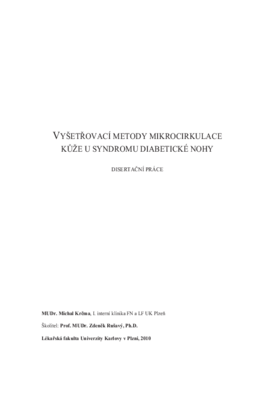Vyšetřovací metody mikrocirkulace kůže u syndromu diabetické nohy
Examination methods of skin microcirculation in diabetes foot syndrome
dizertační práce (OBHÁJENO)

Zobrazit/
Trvalý odkaz
http://hdl.handle.net/20.500.11956/23430Identifikátory
SIS: 93987
Katalog UK: 990012879610106986
Kolekce
- Kvalifikační práce [356]
Autor
Vedoucí práce
Oponent práce
Filipovský, Jan
Horký, Karel
Prázný, Martin
Fakulta / součást
Lékařská fakulta v Plzni
Obor
-
Katedra / ústav / klinika
I.interní klinika
Datum obhajoby
3. 5. 2010
Nakladatel
Univerzita Karlova, Lékařská fakulta v PlzniJazyk
Čeština
Známka
Prospěl/a
Introduction: Since the mid 1980s, a lot of attention has been dedicated to the importance of microcirculation; a part of arterial bed including arterioles, precapillary sphincters, capillaries, venules and arteriovenous shunts. It is a structure of decisive importance for an organism; in its domain an exchange of blood gases and metabolic products takes place and it contributes to thermoregulation. Mediation of vasomotor reaction and vasoarterial reflex maintaining a stable hydrostatic pressure is also an important function. Microcirculation is for its dimensions (capillary diameter approx. 5 x 10-5 mm2, blood flow velocity around 0.4 mm.s-1) relatively difficult to access for more detailed examination, yet its impairments are very severe and dominate in many metabolic disorders. Microcirculation impairment is crucial in diabetes mellitus, where arteriovenous shunts open at the expense of nutritive bed due to a loss of sympathetic tone in peripheral circulation in diabetic neuropathy (Netten, Houben). Blood flow is therefore seemingly sufficient, but the affected tissue undergoes ischemia (warm ischemia). To what extent hyperinsulinemia contributes to this effect is not yet clearly known, one of the possible explanations may be a stimulation of sympathetic activity. Not a few studies are dealing with...
